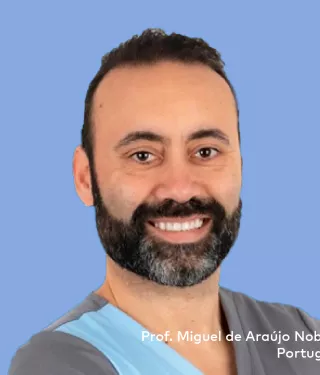
“With proper maintenance, complex cases can still be successful.”
Should edentulous patients with challenging bone anatomy be treated with the All-on-4® treatment concept? We asked Prof. de Araújo Nobre, the first author of a recently published clinical study “The 10-Year Outcomes of Implants Inserted with Dehiscence or Fenestrations in the Rehabilitation of Completely Edentulous Jaws with the All-on-4 Concept.”1
Prof. de Araújo Nobre, why did you and your team decide to conduct this study?
At Research, Development and Education Department of Maló Clinic, we perform clinical research, and we have a saying, “Clinical research is real-life research” because we don’t only include patients with excellent prognoses in our studies. It is normal to have patients seeking treatment that don’t present perfect conditions for All-on-4® treatment concept rehabilitation, such as good bone volume and density, absence of smoking habits, or systemic conditions. In this study's sample, the large majority of patients presented health complications. Eventually, some complications may occur, and it was our objective to prove that with proper maintenance, complex cases can still be successful with at least a decade of follow-up. This, in turn, would enable more clinicians to either avoid complications or handle them correctly.
Did you use the standard All-on-4® treatment concept?
We used the standard All-on-4® treatment concept in almost all cases. The only exceptions were implants with fenestrations in immediate extraction sockets. When the implant was exposed inside a socket, the autogenous bone graft obtained during the smoothing of the bone crest was condensed in the socket to hide the fenestration and prevent soft tissue migration.
How do you discuss the risk of complications with the patients?
The risk of complications is always discussed with the patients during the treatment planning phase prior to surgery, so they can take an informed decision about their rehabilitation. Moreover, the surgical and maintenance teams are prepared before the procedures, to be ready for handling the complication – for example, the existence of pseudo-pockets during the maintenance phase of implants with dehiscence.
What was the rate of biological complications in this study?
We registered an incidence of 9.4% at the implant level and 14% at the patient level, which is within the range that we expect and know from our long-term studies.
What are the most common complications at the prosthesis level?
The most common mechanical complications are acrylic resin crown fracture and prosthetic/abutment screw loosening. These mainly occur in patients with both jaws rehabilitated and/or are heavy bruxers. For these patients, we recommend a strict recall regimen and at least annual prosthodontic appointment for evaluating the occlusion and the prostheses.
Both bruxing habits and implant-supported prostheses as opposing dentition are well-documented risk factors for mechanical complications.
Is there any standard of care when an implant in the All-on-4® treatment concept fails?
It is rare that an implant for the All-on-4® treatment concept cannot be saved, but if it happens, we can insert a new implant after waiting for the bone to heal.
When is a surgeon skilled enough to consider treating compromised patients with the All-on-4® treatment concept?
It is important that these cases are handled by experienced surgeons. Surgeons considering treating compromised patients should first seek training in one of the available All-on-4® high-skill surgical protocol courses.
References
1. de Araújo Nobre M, Lopes A, Antunes E. The 10 Year Outcomes of Implants Inserted with Dehiscence or Fenestrations in the Rehabilitation of Completely Edentulous Jaws with the All-on-4 Concept. J Clin Med. 2022 31;11(7):1939.
Read on Pubmed